Elves Chasm is a section of Royal Arch Creek, a perennial stream flowing into the Colorado River at RM 116.5. It is heavily vegetated with hanging gardens of ferns, mimulus, and cress. Redbud and willows occur along the banks and typha and oscillatoria are present in the stream itself. The plentiful vegetation, cobbled riffles and quiet pools as well as the consistent year round flows of approximately 0.002-0.02 m3/sec (AGFD, 1998) create an ideal habitat for aquatic invertebrates. Flash flooding can occur, but much of the vegetation in the hanging gardens survives as it is out of the flood path. Elves Chasm provides little access or refuge for fish due to slick rock waterfalls almost immediately at the stream mouth, but it is a tremendously productive refuge for invertebrates and the samples taken at this location had both the highest abundance and the highest diversity of all of the locations sampled on the canyon.

We sampled in riffle habitat with a few inches of water flowing over it, a still pool several feet deep with Typha and other emergent vegetation at the edges and in large cobbles below the waterfall pool. We collected insects, oligochaetes and mollusks from 7 orders. Ephemeroptera (mayflies) were by far the most abundant with family Baetidae being the dominant taxa. Family Heptageniidae was the other ephemeropteran present, but had far lower abundance. Diptera (true flies) were also well represented with the dominant taxa being Chironomidae and Simuliidae. Also present but with far fewer individuals were Empididae and Ceratopogonidae. Ceratopogonidae adults, also known as no-see-ums, would make an appearance in the lower Canyon several days later and cause a profusion of bleeding, itchy bites that plagued us for days. We collected three families of Trichoptera (caddis flies), including Rhyacophilidae, Hydropsychidae and Limnephilidae. Individuals from order Hemiptera (true bugs) were present as well with family Notonectidae collected and visual encounters with family Gerridae. We also collected Coleoptera (beetles) from family Elmidae, and Haliplidae; several snails (family Physidae) and one Odonata (dragonflies and damselflies) in family Coenagrionidae.

We found invertebrates from three main functional feeding guilds at Elves Chasm. The collector/filterer feeding guild dominated the aquatic taxa with 92.3% of the invertebrates sampled falling into this category. The scraper/shredder guild represented 1.6% of the invertebrates sampled, and predators made up the remaining 6.1% of invertebrates in the samples. The prevalence of collector/filterer insects indicates there is a high degree of processing going on within the system and initial shredding of organic matter is further upstream. While there are obviously organic carbon inputs coming from the macrophytes and other streamside vegetation, organisms that rely on shredding coarse particulate organic matter were not heavily represented in our samples. The abundance and diversity of invertebrates shows that Elves Chasm has been fairly stable in the last few months, which is also indicated by the young vegetation at the water’s edge.
While fish cannot get up into Elves Chasm, the profusion of invertebrate life present doubtlessly influences the mainstem with invertebrate drift caused by high flow events and frequent disturbance from rafters shuffling through the water. Because of the daily fluctuating flows that perturb the mainstem food base into very low abundance, Elves Chasm likely provides extremely important food inputs for mainstem fishes, despite their absence in the lower pools at the time of our sampling.
